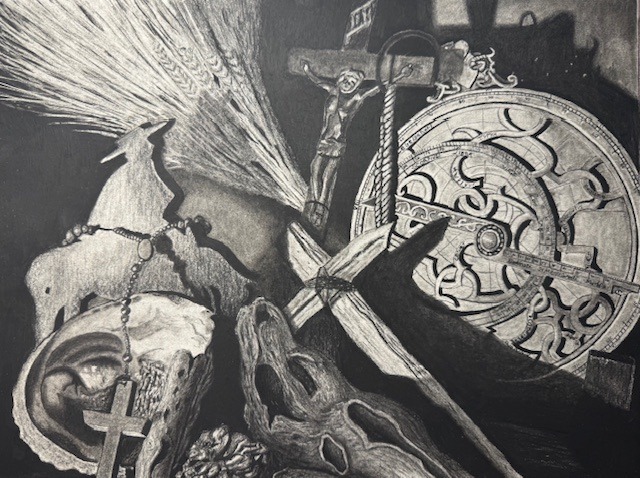-
 February 11, 2025Gerry Gabel is a parishioner at St. Andrew the Apostle Parish in Sierra Vista. He recently drew a beautiful still life, inspired by Venerable Padre Kino. Read more about his inspiration below.
February 11, 2025Gerry Gabel is a parishioner at St. Andrew the Apostle Parish in Sierra Vista. He recently drew a beautiful still life, inspired by Venerable Padre Kino. Read more about his inspiration below.
"I created this still life of Padre Kino as my final project for Art106, Drawing Foundations, at Cochise College. It was drawn in charcoal and represents a variety of elements that harken back to Padre Kino.
"In the upper left is a sheaf of 'Kino wheat' remembering his remarkable agricultural genius and his lasting impact on the fruitfulness of the desert southwest where he had such an impact. To the left middle is a wood silhouette carving of Padre Kino on horseback where he spent such a stunning amount of time as he traversed Arizona, Baja California, Sonora, and other areas of Mexico. A rosary, reminding of his devotion to the Blessed Mother, drapes across the horse and rests in an abalone shell in the bottom left and leans on a cholla branch. The abalone shell remembers Padre Kino's remarkable insight which led to European realization that California was not an island and spurring Padre Kino to redraw all the maps of the southwest region. At the bottom is a saguaro boot, a symbol of new homes in this desert landscape. In the middle, a cross of two sticks leans toward the silhouette. Wrapped with grass, this approximates the crosses the indigenous peoples would hold up in greeting to Padre Kino when they saw him riding out to visit them. Above that in darker relief is a mission cross, reminding of the 21 missions founded by Padre Kino during his 24 years in this region. The right side is dominated by an astrolabe, used to calculate the latitude and longitude using the sun and the stars. Padre Kino was a toolmaker of navigational devices, as well as a consummate map maker and navigator who literally redrew European understanding of the geography of what would become the southwestern United States and western Mexico.
"Though it was not part of my intent, I realized after I had finished that there is a balance of travel and home in this composition. The astrolabe, stick and grass cross, abalone, and the Padre on Horseback cutout harken to the travel that Padre Kino heroically engaged, both in his journey across the Atlantic Ocean and in and through Mexico and the southwest US. But he also built a home, and the mission cross, wheat, rosary, and saguaro boot suggest the idea of roots, of committing to a place and building a home."- Gerry Gabel
